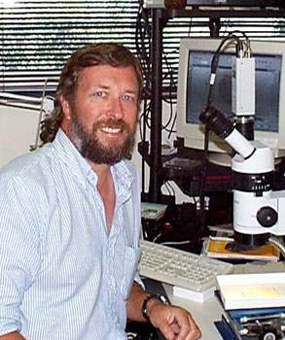 |
| Ted Fremd is the head of the paleontology division at the fossil beds. |
 |
Theodore J. Fremd
Paleontologist/NPS Science Advisor
Each science advisor performs specific roles and functions to support the goal of bringing science and scholarship to PWR parks, the Regional Directorate, and to the National Park Service. The information below is intended to highlight areas of expertise, current activities, and capacities of individual PWR Science Advisors.
Disciplinary and/or geographic expertise:
Vertebrate paleontology, biostratigraphy, taphonomy, paleoecology, curation of natural history specimens, and management of paleontological specimens.
Science liaison capacity:
Faculty member, University of Oregon, Department of Geological Sciences, Eugene, OR
Paleontological research coordinator; interagency agreements with U. S. Bureau of Land Management (four districts), U. S. Forest Service (three National Forests in Oregon and Washington), U. S. Fish and Wildlife Service, Oregon State Parks, The Confederated Tribes of the Warm Springs, The Natural Conservancy, Oregon Museum of Science and Industry, varied private lands with significant fossil resources.
Society of Vertebrate Paleontology (Government Laiason Committee), AAAS, Geological Society of America, Paleontological Society, etc.
NPS Natural History Collections ad hoc committee; Chair, NPS Collections Significance Group (Paleontology), NPS Museum Management Program Council, PWR GIS Committee
World Heritage Assessment, Ipolytarnoc National Park, Hungary
Science needs identification and assessment:
Paleontological resource conservation on public lands
Curation, laboratory, and fieldwork methods with fossilized biotas
Phylogenetic systematics and evolutionary paleoecology
Synthetic focus:
Applicability of “deep time” perspectives to modern ecological syntheses; defragmentation of spatially broad (basin-scale) Tertiary paleontological deposits and their entombed biotas
Strategic resource management approaches:
Relevance of evolutionary paleoecology in conservation of recent biotas; preservation and curation of paleontological resources.
Recent activities include: Paleontological Survey, Wrangell-St. Elias National Park, Alaska; team member of Petrified Forest Paleontological Resource Planning, etc.
Analytical Focus (selected publications):
Bestland, E. A., G. J. Retallack and T. Fremd (1994). Sequence stratigraphy of the Eocene-Oligocene transition: examples from the non-marine volcanically influenced John Day Basin. Field Trip Guidebook of the Annual Meeting of the Geological Society of America: 19 pages.
Bryant, H. N. and T. J. Fremd (2001). The evolutionary history of the Nimravidae (Carnivora) in the John Day Basin of Oregon. PaleoBios 21: 2: 35-36.
Coombs, M. C., Robert M. Hunt, Jr., Ellen Stepleton, L. Barry Albright III, and Theodore J. Fremd (2001). Stratigraphy, Chronology, Biogeography, and Taxonomy of Early Miocene Small Chalicotheres in North America. Journal of Vertebrate Paleontology 21(3): 607-620.
Foss, S. E. and T. Fremd (1998). A Survey of the Species of Entelodonts (Mammalia, Artiodactyla) of the John Day Basin, Oregon. Dakoterra 5: 63-72.
Fremd, T. (1999). Places of Discovery: Paleontology, Research, and Natural Areas. IN: Harmon, D., Ed. Proc. 10th. Conf. on Research and Res. Man. In Parks. 130-137.
Fremd, T. (1995). Cyclic Prospecting to Preserve Vertebrate Paleontological Resources. San Bernardino County Museum Association Quarterly 4(2): 19-25.
Fremd, T. J. (2001). Paleontology data and NPS collections: unbounded resources, or, between managers and scientists. Crossing boundaries in park management: Proceedings of the 11th Conference on Research and Resource Management in Parks and on Public Lands. D. Harmon. Hancock, Michigan, The George Wright Society: 342-348.
Fremd, T. J. and X. Wang (1995). Resolving Blurred Faunas: Biostratigraphy in John Day Fossil Beds National Monument. NPS Paleontological Research., Technical Report NPS/NRPO/NRTR-95/16. V. Santucci and L. McClelland: 73-76.
Fremd, T. J., E. A. Bestland and G. J. Retallack (1994). John Day Basin Field Trip Guide and Road Log. 1994 Society of Vertebrate Paleontology Annual Meetings, Northwest Interpretive Association. 80 pp.
Fremd, T. (1996). Fruits and Seeds of the Middle Eocene Nut Beds Flora, Clarno Formation, Oregon Oregon Geology 58(3): 70-71.
Fremd, Ted. (1997). Cooperative Management of “Our Fossil Heritage”: An Example from the John Day Basin. IN: Johnston, M. and J. McChristal, eds. Partners in Paleontology. NPS/NRFLFO/NRR-97/01
Fremd, T. (1992). "Time in the Blue Mountains." Natural Resource News 2(4): 7-10.
Kohn, M. J., Miselis, J. L., and T. J. Fremd. (2002). Oxygen isotope evidence for progressive uplift of the Cascade Range, Oregon. Earth and Planetary Science Letters 204 (2002): 151-165.
Retallack, G. J. and T. J. Fremd (1996). "Reconstructions of Eocene and Oligocene plants and animals of central Oregon." Oregon Geology 58(3): 51-69.
Retallack, G. J., Bestland, E. A., and T. J. Fremd. (1999). Eocene and Oligocene paleosols of central Oregon. Geological Society of America Special Paper 344: 192 pages.
Retallack, G. J., Wynn, J. G., and T. J. Fremd (2004). Glacial-interglacial-scale paleoclimatic change without large ice sheets in the Oligocene of central Oregon. Geology: V. 32, no.4; p. 297-300.
Convener and Editor, John Day Basin Paleontology Symposium, NAPC, U. C. Berkeley. Paleobios: in press.
Science capacity facilitation:
Pacific West Region Science Advisors
Coauthor of NPS-77 Paleontology Guidelines
Attract and advise graduate students; serve on thesis committees re: Cenozoic paleoecology
| 





